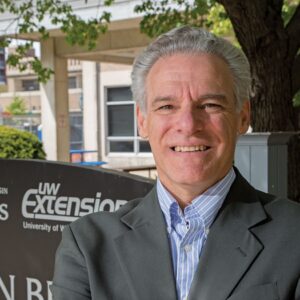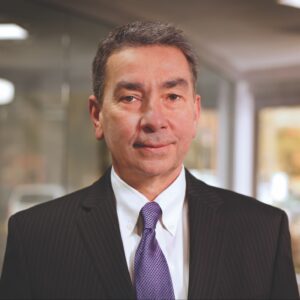The second CBE wave—more grounded and focused on quality than the first—is underway, and resources to support development of high-quality programs include the University of Wisconsin Flexible Option case study.
Fear of being left behind in the chalk dust triggered the first wave of interest in competency-based education—or CBE—in the early 2000s. In 2012, that wave overlapped with a spike in MOOC fever (during what The New York Times dubbed “The Year of the MOOC”), a $1 trillion milestone in student-loan debt, and a Lumina Foundation/Gallup study on “America’s Call for Higher Education Redesign” noting the desire for “a new system of credentials and credits that is defined by learning and competencies rather than time.”
The second wave of CBE underway now is triggered not by an interest in the “next big thing” but by purpose. This approach is endorsed by ACE, Ellucian and Eduventures in a recently published study on Deconstructing CBE: An Assessment of Institutional Activity, Goals, and Challenges in Higher Education, which urges institutions “to carefully weigh the pros and cons of CBE and determine their path forward proactively rather than in reaction to a swell of popularity.”
Proactive higher education leaders are now exhibiting a more realistic, grounded approach to develop high-quality, scalable programs. The question has shifted from, “How do we get on board before this ship of CBE schools sails without us?” to, “How do we get started and sustain our efforts?”
Several models, including one through the University of Wisconsin (UW) System, are helping other institutions navigate the current question.
Through Lumina Foundation support, UW System chronicled the development and delivery of the direct assessment, competency-based UW Flexible Option as a resource for higher education policymakers, leaders, faculty and staff interested in CBE.
Our academic model is working: UW Flex has served 1,345 students between January 2014 and August 2017, with 187 students earning credentials during that period. Our retention rate of 70 percent or higher among bachelor degree-seeking students is remarkably high for what is essentially an open-access program.
Our business model is built on each Flex academic program breaking even within five years of its start-up. Revenue, based entirely on enrollments, is shared among partner institutions for that academic program once we break even. UW-Extension reinvests its share of program revenue for curriculum revision. Our enrollments are on track to break even for our five-year plan.
UW Flex is successful, but we recognize that it is one version of successful CBE. We frame our story as a description of our experience rather than a prescription.
The UW Flexible Option case study at go.uwsa.edu/cbe reflects pivotal moments, lessons learned, and decisions made from the 2012-13 early development phase to the 2014 launch and subsequent growth in the academic program array and enrollments.
Here, based on the UW Flex experience, are steps on a scalable path.
Four Steps on a Proactive CBE Path
- Clarify purpose and create a business plan.
Clarity of purpose is essential for anyone developing a CBE program. Is the purpose to increase access? Grow revenue? Improve job training and fill skills gaps?
Creating a business plan forces this discussion and builds a business case for the new program. At the most basic level, the plan answers the questions: What will the new CBE programs cost, and how will we pay for them? A well-developed, thoroughly vetted business plan also serves as a roadmap, touchstone and communication tool. It details the functions, systems, roles and personnel required to ensure student and program success; presents worst-case and likely case scenarios; informs decision-making to keep on track toward enrollment and revenue targets; and builds the case for scalability of academic offerings, operations, infrastructure, and, ultimately, CBE program viability.
For the UW Flexible Option, our governing board—the UW System Board of Regents—requested a business model based on each academic program breaking even within five years after its launch. That directive led to the development of a cost-recovery, revenue-sharing business plan and centralized operational model to ensure viability of our project-based, direct assessment CBE academic model.
- Align program offerings with the business plan.
For the UW Flexible Option, aligning what programs are developed with the business plan was critical and necessitated addressing the most urgent employment needs and public interest, high job growth areas and student demand. Health care, technology and business programs satisfied this criteria in our state and are represented in our current choice of programs.
A Substance Use Disorders Counselor certificate program illustrates the criteria we set for programs: strong employment need demonstrated by the Bureau of Labor Statistics, student demand among working counselors who need to complete training that fits their schedules, and public interest as state licensure requirements changed under the Affordable Care Act to ensure counselors are better qualified to respond to this health crisis. Offered through partnership with UW-Madison, this program is the first in the UW Flexible Option to break even (within 18 months of inception) and bring in program revenue.
As a caveat, we note that offering high demand academic programs—such as a bachelor of science in nursing (BSN)—pits an institution against competitors in a crowded educational marketplace. We relied on curricular design and marketing to distinguish the UW Flex BSN program within this crowded marketplace, as we describe in the Academics: Program Identification section of our case study.
- Develop a high-quality academic model and learning environment that respond to the needs of students.
UW System and UW-Extension leaders envisioned education that was flexible enough for nontraditional students who juggle family and work and who are bound by schedules and locations that preclude traditional classroom programs or traditional online programs. The challenge was to develop programs in which students could apply disciplinary knowledge to move through the curriculum more quickly, and ones that are not restricted to semesters and whose pace is driven by students.
Nontraditional students in this market prefer to control their learning environment, such as when they start their education; when and where they access curriculum materials and assistance; and how quickly or slowly they move through their program, with the ability to easily monitor their own progress and to take breaks without losing ground.
In response, we developed a non-credit, non-term, direct-assessment environment that allows students to progress at their own pace. There is no penalty for going fast or slow. Students are guided by faculty and other academic supports, as illustrated in this video introduction to the UW Flexible Option model.
UW Flex provides personalized guidance, support, and encouragement through Academic Success Coaches and a highly structured online learning environment with intuitive navigation, consistent organization of materials and persistent links to resources and support. To ensure curricular quality, the curriculum is led by University of Wisconsin faculty and grounded in pedagogy, as we detail on our website.
- Build economies of scale to ensure sustainability.
Sustainability depends on effective delivery of what students want and need and on efficient use of resources.
For a high-touch online program such as UW Flex, technology systems must provide staff and faculty access to up-to-date interactions with prospective and current students to see their status, manage relationships, and reach out to them when they need help.
We relied on some manual processes in the early days. Doing so with a relatively small student population helped us clarify business practices before codifying them in technology. Now that we’ve implemented our technology systems, continuous improvement of them helps support student and program success. For example, based on recent research, we are incorporating early warning indicators into our student information system to identify students at risk for dropping out.
Interest in CBE remains high, yet “the complexities of implementing and defining CBE [have] kept most institutions wholly or primarily at an aspirational phase of implementation,” according to “Deconstructing CBE.” What helped UW Flex move beyond aspiration was a clarity of purpose, a thoroughly vetted business plan, consideration of factors critical to success, and making data-informed decisions.
We hope that the UW Flexible Option experience—via go.uwsa.edu/cbe—is a valuable resource for others looking for new ways to educate more people in our nation. Greater access to quality education supports the academy’s collective efforts to improve the health and wellbeing of our citizenry, our communities, our country and our world.

Resources for Those Riding the CBE “Second Wave”
- The Competency-Based Education Network (C-BEN) formed in 2014 to help colleges and universities address challenges in CBE design, delivery and ability to scale. C-BEN is hosting its third annual CBExchange Sept. 20-22, 2017, to look at best practices, design elements, and new resources for those developing programs. Also, C-BEN Executive Director Charla Long announced that C-BEN will launch a CBE virtual collaboration platform for those interested in connecting and working with others on shared projects.
- The Journal of Competency-Based Education, launched by Western Governors University in 2016, provides scholarly research, case studies and commentary.
- “Survey of the Shared Design Elements & Emerging Practices of Competency-Based Education Programs,” a 2015 Public Agenda survey, identifies what those developing CBE consider important to ensure quality and the ability to scale a CBE model.
- “Deconstructing CBE: An Assessment of Institutional Activity, Goals, and Challenges in Higher Education,” published in 2017 by ACE, Eduventures and Ellucian, is a CBE study designed to help higher education leaders understand the current diverse CBE landscape and potential for various scalable approaches.
- Navigating the CBE Frontier, a blog series in The Evolllution by University of Wisconsin-Extension Provost Aaron Brower, shares lessons, insights and reflections—based on the UW Flexible Option experience—on developing, launching and maintaining a competency-based program.
- The UW Flexible Option case study website provides takeaways, challenges, resources, and research findings based on the University of Wisconsin System and UW-Extension experience developing and delivering a direct assessment, competency-based program. Funded through a Lumina Foundation grant, this resource is designed for higher education leaders, policymakers, faculty and staff developing CBE programs. A description of the six main content areas follows.
1. Academics answers how we decide what academic programs to offer, how we ensure quality, and how we develop curriculum and engage faculty. Resources include an illustration detailing the step-by-step curriculum development process, videos on project-based curriculum development and proficiency assessment, faculty presentations on incorporating critical thinking, a look at faculty roles and engagement, and a transcript model.
2. Budget addresses how we estimate expenses and revenues, why we value our business plan, and what we found helpful to incorporate in our plan. Resources include a business plan template based on the UW Flex plan.
3. Communications details how we build stakeholder relationships and includes insights about our media and marketing approaches. The communications plan template provided is based on the UW Flex plan.
4. Enrollment Management and Technology discusses the Academic Success Coach role central to student services, the IT staffing leadership and technologist roles developed, the transformation required from maintenance to development of IT systems, and the need for student-centric IT support in our multi-institutional environment.
5. Metrics highlights the need for new definitions and measures of student and program success and for direct comparisons of student outcomes for CBE and traditional programs.
6. Policy presents an overview—through video and text—of the regulatory framework and approval process impacting CBE programs, particularly direct assessment models, and includes May 2017 UW System and UW-Extension recommendations for regulatory reform.
If you have any questions or comments about this blog post, please contact us.



